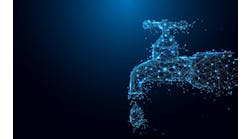Furnace, vessel, and column pressure control loop have an integrating response because an increase in pressure does not cause a significant increase in flow out of the volume. The self-regulation is negligible because flow is proportional to the square root of the pressure and the change from a deviation in pressure from setpoint is small compared to the normal valve drop. In some cases, flow is critical and independent of pressure drop. Even if the pressure response is self-regulating, the steady state for an upset is often beyond the operating range and trip or relief settings. Consequently, the pressure is a ramp in the control region and gas pressure can be treated as a near-integrating or true integrating response. The fastest ramp rate and a lambda (closed loop arrest time) almost as small as the maximum deadtime should be used for tuning for maximum disturbance rejection.
The PID gain and reset time are both generally set too small for gas pressure loops unless integrator tuning rules with a low lambda were used with an auto tuner or adaptive tuner. A simple fix is often to simply increase the reset time by a factor of ten or more and then gradually increase the PID gain.
Tuning tests should be done with the pressure controller in automatic. Open loop response tests are not generally advisable. To test the response to load disturbance, the step or pulse into the controller output must not require the controller be out of automatic for more than one execution. For analog control holdouts, the test must be done without any interruption of automatic action.
Analog controllers are required if the pressure can ramp halfway or more to a trip setting in less than the minimum execution time of the PID in a DCS or PLC (e.g., 0.1 second). Almost always the final control element is a hydraulic actuated valve or governor or a fan speed regulated by a variable frequency drive with a negligible deadband and speed rate limiting. An air actuated control valve, damper, or guide vanes are too slow for these loops and are thus a clue that a DCS PID is fast enough.
For large valves and dampers, boosters are required to reduce the pre-stroke deadtime to less than 10% and the stroking time to less than 50% of the fastest excursion time (e.g. allowable control error divided by the maximum pressure ramp rate from a disturbance). A booster should not be used instead of a positioner because the high outlet port sensitivity causes positive feedback that has been show to cause diaphragm actuated butterfly valves to slam shut. The booster should be on the output of the positioner as shown in slides 91 and 92 in the ISA Edmonton short course "Effective Use of Measurements Valves and PID Controllers". The booster bypass valve must be slightly opened so the positioner sees some of the volume of the actuator to prevent fast cycling.
Beware of dampers. Often dampers have linkages with excessive backlash and restrictors on positioner outputs to prevent cycling from large changes in torque requirements. Consequently, many dampers have too much deadband and too long of a stroking time. Guide vanes on compressors offer greater precision and turndown and energy efficiency than dampers.
Split range control is used to increase the rangeability and to provide the ability to pressurize besides depressurize a system. Often a small inert valve is used in combination with a large vent valve. These valves should have a stiction and deadband of less than 0.2% near the closed the position. Adaptive tuning that is scheduled based on controller output should be used to compensate for the change in the integrating process gain with each valve.
A linear trim should normally be used in the control valves. The installed characteristic is the inherent characteristic because most of the system drop is the pressure drop across the valve. For pressure relief, sometimes a quick opening valve characteristic is suggested but this introduces a nonlinearity necessitating the detuning for the steep slope near the closed position negating the advantage. Also, stick-slip which is greatest near the seat will cause a greater limit cycle near the split range point.
To prevent a high pressure trip and unnecessary crossings of the split range point, the vent valve should be fast opening and slow closing. This difference in stroking speed can be achieved by external-reset feedback and a setpoint rate limit (velocity limit) added to the analog output (AO) block in the direction of closing the valve. The AO setpoint should be used for external-reset feedback so the PID output does not change faster than permitted by the AO in the direction of closing the surge valve.
A valve position controller (VPC) can lower the compressor or fan discharge pressure to force the furthest open downstream user control valve to a maximum throttle position. A VPC can also lower a column pressure to the limit of the vacuum system capability. The VPC should provide a slow decrease in pressure setpoint and a fast increase in pressure setpoint as needed. A velocity limit on the VPC output to the pressure controller setpoint and external-reset feedback can provide this slow approach to the optimum and fast getaway to prevent the user from running out of valve. An enhanced PID developed for wireless can ignore limit cycles and small changes in downstream user valve position.
The PID controller scan time should be less than 10% of the fastest excursion time. The total of the pressure measurement sensor lag time, filled system lag, wireless update rate, damping setting and filter time setting must not introduce a delay or lag longer than 10% of the fastest excursion time. In my experience, the fastest excursion time can range from 0.5 to 2.0 sec for compressors, 0.05 to 2.0 sec for furnaces, 2 to 20 seconds for headers and vessels, and 5 to 60 seconds for columns. Actual ramp rates should be measured online. A deadtime block in the PID module with a deadtime setting to give a good signal noise ratio can used to compute ramp rates as noted in the June 29, 2012 Control Talk Blog "Future PV Values are the Future". Wireless pressure measurements can generally be used on column pressure control if the default update rate and trigger level provide fast enough updates for the fastest excursion time.
Direct mounting of pressure transmitters is preferred. For furnace, kiln and dryer applications, the pressure probe should be designed to minimize measurement noise and kinetic heads or suction effects due to high velocities and sensitive pressure ranges (e.g., fractional inches of water column). Diaphragm seals and capillary systems introduce a time lag of 1 or 2 seconds and a threshold sensitivity of 0.2% but can be used if necessary on large vessels operating with a pressure span of an atmosphere or more.
For a deeper understanding of the dynamics, modeling, and control of compressors, my book Centrifugal and Axial Compressor Control has been put back into print my Momentum Press. The throughput control chapter covers various methods of compressor pressure control.
Note that the fastest excursion time is the maximum allowable control error around setpoint divided by the maximum ramp rate of the process variable for the worst case disturbance.
•(1) Is the PID execution time less than 10% of the fastest excursion time?
•(2) Is the total of the measurement sensor lag, filled system lag, wireless update rate, transmitter damping setting, and filter setting, less than 10% of the fastest excursion time?
•(3) Does the pressure probe design sufficiently reduce noise, static head, and suction effects where velocities are high and pressure spans are small (e.g. inches of water column)?
•(4) Can inlet guide vanes be used for compressor pressure control to increase efficiency and turndown?
•(5) Do the guide vanes, control valves, and dampers have a deadtime less than 10% and a stroking time less than 50% of the fastest excursion time?
•(6) Do the control valves and dampers have a backlash and stick-slip less than 0.2%?
•(7) Do split range valves have linear trim?
•(8) Is the PID gain and reset time high enough?
•(9) Was the PID tuned with integrator rules with lambda approaching the maximum deadtime?
•(10) Does the PID need to stay in automatic to prevent an excessive pressure excursion?
•(11) Is a fast opening and slow closing analog output rate limit with external-reset feedback needed on a vent valve?
•(12) Can a valve position controller (VPC) that provides a slow approach to an optimum and a fast getaway be used with external-reset limits and the enhanced PID option to provide a more optimum pressure setpoint for compressor, fans, and columns?




